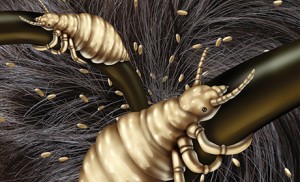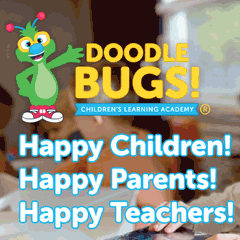Head Lice 101
The head louse is a small, wingless parasitic insect that lives among human hairs and feeds on tiny amounts of blood drawn from the scalp. Lice (the plural of louse) are a common problem among kids. They’re contagious, annoying, and sometimes tough to get rid of, but they aren’t dangerous, although lice bites can make a child’s scalp itchy and irritated, and scratching can lead to infection.
Signs of Head Lice
Lice eggs (called nits). These look like tiny yellow or brown dots, sort of like dandruff, before they hatch. Lice lay nits on hair shafts close to the scalp, where the temperature keeps them warm until they hatch.
Unless the infestation is heavy, it’s more common to see nits in a child’s hair than it is to see live lice crawling on the scalp. Lice eggs hatch within 1 to 2 weeks after they’re laid. After hatching, the remaining shell looks white or clear and stays firmly attached to the hair shaft.
 Adult lice & nymphs (baby lice). The adult louse is no bigger than a sesame seed and is grayish-white or tan. Nymphs are smaller and become adult lice about 1 to 2 weeks after hatching. Most lice feed on blood several times a day, but they can survive up to 2 days off the scalp.
Adult lice & nymphs (baby lice). The adult louse is no bigger than a sesame seed and is grayish-white or tan. Nymphs are smaller and become adult lice about 1 to 2 weeks after hatching. Most lice feed on blood several times a day, but they can survive up to 2 days off the scalp.
Scratching. This is actually due to a reaction to the saliva of lice. However, the itching may not always start right away ─ it depends on how sensitive a child’s skin is─ and can sometimes take weeks. They may complain, though, of things tickling their heads.
Small red bumps or sores from scratching. For some kids, the irritation is mild; for others, a bothersome rash may develop. Excessive scratching can lead to a bacterial infection (causing swollen lymph glands and red, tender skin that might crust and ooze). Your doctor may treat the infection with oral antibiotics.
You may be able to see the lice or nits by parting your child’s hair into small sections and running a fine-tooth comb through the scalp, behind the ears, and around the nape of the neck (it’s rare for them to be found on eyelashes or eyebrows). A magnifying glass and bright light may help. It can be tough to find a nymph or adult louse ─ often, there aren’t many of them and they move fast. Call your doctor if you suspect that your child is infested with lice (note: not all kids have the classic symptoms). Check with your child’s school nurse or childcare center to see if other kids have recently been treated. If your child does indeed have lice, contact the school to inform and to learn about the return policy. Most usually allow kids to return after one topical treatment has been completed.
Are Lice Contagious?
Lice are highly contagious and can spread quickly, especially in group settings (like schools, childcare, parties, sports activities, and camps). Though they can’t jump, these parasites have specially adapted claws that let them crawl and cling firmly to hair. They spread mainly through head-to-head contact, but sharing clothing, linens, combs/brushes, and hats can easily cause transfer. Kids are most prone to catching lice because they often have close contact with each other and share these items.
Rest assured that pets can’t catch head lice and pass them on to people or the other way around.
Treatment
Your doctor can recommend a medicated shampoo, cream rinse, or lotion to kill the lice. These may be over-the-counter or prescription medications. Medicated lice treatments usually kill the lice and nits, but it may take a few days for the itching to stop. For very resistant lice, an oral medication might be prescribed. It’s important to follow the directions exactly because these products are insecticides. Applying too much medication ─ or using it too often ─ can increase the risk of causing harm.
Treatment may be unsuccessful if medication is not used correctly or if the lice are resistant to it. Your doctor may suggest combing out the nits with a fine-tooth comb and recommend repeating treatment in 7 to 10 days to kill newly hatched nits.
There are many new innovative products in the market that don’t use harsh chemicals and have proven to be successful against lice. RobiComb by LiceGuard is an electric lice comb designed to electrocute lice on contact as the comb slides through clean, dry hair. After being “zapped” the lice and eggs die instantly (or soon after) and then are unable to produce any more lice. RobiComb is safe for everyday use on kid; however, manual remove is still required to discard any small eggs and nits that are attached to the hair. Luckily LiceGuard has other non-toxic product that assist in this process as well. Learn more by visiting www.LiceGuard.com
Removing By Hand
If your child is 2 years old or younger, you should not use medicated lice treatments. You’ll need to remove the nits and lice by hand. Use a fine-tooth comb on your child’s wet, conditioned hair every 3 to 4 days for 2 weeks after the last live louse was seen. Wetting the hair is recommended because it temporarily immobilizes the lice and the conditioner makes it easier to get a comb through the hair.
Wet combing is also an alternative to pesticide treatments in older kids. Though petroleum jelly, mayonnaise, or olive oil are sometimes used in an attempt to suffocate head lice, these treatments aren’t effective. Keep in mind that lice don’t survive long once they fall off a person, so you don’t need to spend a lot of time trying to rid the house of lice.
Preventing Reinfestation
- Wash all bed linens and clothing that’s been recently used by anyone in your home who’s infested in very hot water (130° F), then put them in the hot cycle of the dryer for at least 20 minutes.
- Dry-clean anything that can’t be washed (like stuffed animals). Or put them in airtight bags for at least 3 days.
- Vacuum carpets and upholstered furniture (in your home or car), then throw away the vacuum cleaner bag.
- Soak haircare items like combs, barrettes, hair ties or bands, and headbands in rubbing alcohol or medicated shampoo for 1 hour. You can also wash them in hot water or just throw them away.
Because lice are easily passed from person to person in the same house, bedmates will also need treatment to prevent the lice from coming back.
Dont’s
- Don’t use a hairdryer on your child’s hair after applying scalp treatments because some contain flammable ingredients.
- Don’t use a conditioner or shampoo/conditioner combination before applying lice medication.
- Don’t wash your child’s hair for 1 to 2 days after medicated treatment.
- Don’t use sprays or hire a pest control company to try to get rid of the lice, as these treatments can be harmful.
- Don’t use the same medication more than three times on one person. If it’s not working, your doctor may recommend another option.
- Don’t use more than one lice medication at a time.
Tips To Remember
Having head lice is not a sign of dirtiness or poor hygiene. The pesky bugs can be a problem for kids of all ages and socioeconomic levels, no matter how often they wash their hair or bathe. However, these tips can help:
- Tell kids to avoid head-to-head contact in the gym, playground, or during sports and while playing with other children.
- Tell kids not to share haircare items, hats, scarves, towels, helmets.
- Tell kids not to lie on bedding and carpets that have recently been used by someone with lice.
- Every 3 or 4 days, examine members of your household who have had close contact with a person who has lice. Treat any who are found to have lice or nits.
Will They Ever Be Gone?
As many parents know firsthand, lice infestation can be an ongoing battle, especially in group settings. There’s no doubt that they can be hard bugs to get rid of. If you’ve followed every recommendation and your child still has lice, it could be because some nits were left behind, your child is still being exposed to someone with lice, or the treatment you’re using isn’t effective. If your child still has lice 2 weeks after you started treatment or if your child’s scalp looks infected, call your doctor.
No matter how long the problem lasts, be sure to remind your child that, although having lice can certainly be embarrassing, anyone can get them. It’s important for kids to understand that they haven’t done anything wrong and that having lice doesn’t make them dirty. Reassure them that, as frustrating as getting rid of lice can be, there is light at the end of the tunnel.
© Nemours/KidsHealth.org. Reprinted with permission.









